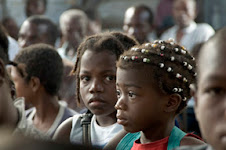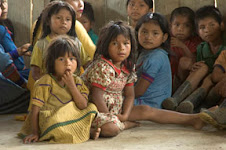
Sabaleta—an Embera-Chamí community in the "highway" district
Last weekend I was privileged to make a five-day visit to Sabaleta, a community I had seen previously from “the Trocha.” Below I’m going to use this visit to touch on a theme of mine—the problems of cross-cultural communication, and particularly the importance of not assuming you know what you’re looking at, or what it means.

But first, a few words about the community. The Chamí are one of the three ethnic groups that comprise the Embera in Colombia. The name refers to water springs, and is drawn from the Chamí’s original area, in the department of Risaralda, and especially around the community of San Atnonio de Chamí. From that area, mostly in the last two centuries, the people have spread into other departments—Antioquia, Valle del Cauca, Caldas, Putamayo, and of course, El Chocó. Although in reality there are only two communities in this department.
The Embera-Chamí of Sabaleta first came here around 1880—in the same period that Guadguas, not that far away, was being settled. The immediate cause was the violence of that epoch (unfortunately, for most of Colombian history, it would not be wrong to refer to “the violence of that epoch”). They settled in this area, not far from a number of Embera-Katío communities.
The community has grown considerably in recent years. I was told that 35 years ago, they had twelve families and 33 residents. Today, there are 98 families, of whom about 90 live in or very near the caserío, or settlement, and nearly 500 people. About 30 years ago, a group left and founded El 20, the only other Chamí community in the area.
Violence has had other effects on he community. I was told that the folks here abandoned the worship of the god Caracabí (known as Alcolé—the great father) only a generation ago, in response to the work of priests in attending to and comforting the victims.
Compared to the other Embera communities along the trocha, Sabaleta is quite “acculturated.” Almost all the people speak good Spanish, including women and little kids; really it’s a truly bilingual community. Many, if not all, the adults are high-school graduates. Women are active and outspoken in the community. The clothing they wear is very mixed, and heavily “western”-influenced—you don’t see anyone wearing the “paruma” (wrap-around skirt that is the only article of clothing for more traditional Embera women). But there are great mixtures: women wearing pants but carrying heavy loads of firewood or plátanos in traditional baskets with head-straps. But one of the teachers in the school told me that the village she comes from, in Antioquia, is much more “acculturated,” as all, not just a few, of the houses are of blocks and cement, and people have refrigerators and TVs in their houses. But they still speak Embera padea at home.
The people in Sabaleta were very welcoming, and I certainly had a wonderful visit—I hope to write more about them in the future. But for now, the question about understanding what you see…
Here’s an example. Right in the middle of the caserío there’s a row of ten houses that are different from the rest. They are attached, for one thing. They are not elevated. And most are of block or mixed block and wood construction, rather than the traditional wood.
So here are a couple of questions that might arise, if you think to ask:
1) Why are these houses made like this?
2) While we’re on the topic, is the caserío laid out in a traditional way?
The danger—the trap—is to try to understand these questions simply by looking. (I’m not creating an easy target here—I’ve seen lots of visitors in towns and villages in Latin America do just that). But the information is not on the surface; you can’t understand by looking. You have to ask. This may seem obvious, but as I said, my experience tells me that it bears repeating. And especially when we think about photography, which tends by the very nature of the medium to promote the idea that all the information we need is already in front of us. But this is rarely the case, and certainly not so here.
The row of houses were built in 1997 by a project, apparently arranged by the municipal government, and I was told that although the people were consulted before construction began about what they wanted, they were surprised to see attached houses. I heard conflicting stories about whether they have adjusted to them or not.
In any event, they hadn’t been in them very long when in 198 the paramilitaries gave the people 24 hours to abandon the area. At that time, there was no caserío; the people lived in their traditional manner spread out through the mountains, on their fincas. People headed for the hills, and were able to send a commission to El Carmen, and the municipio sent vehicles to get them. In the meantime, the paracos killed two students!
They stayed in El Carmen for six months before they could return. This was hard on them. For one thing, they traditionally did not live in a capitalist culture—they didn’t buy their food, they grew it—and in El Carmen, they had to buy everything, but didn’t have incomes.
When they were able to return, they decided—this was a position of the regional indigenous organization, OREWA—that for greater security and unity, as well as to develop communal programs, it would be better to live closer. In an area that had been pasture, they created the caserío with help from Catholic Relief Service (CRS), who financed the houses.
So, there are answers to the questions, but they don’t come simply from looking.


Sabaleta—una comunidad embera-chamí en la zona de la "carretera."
El fin de semana pasado tuve el privilegio de visitar Sabaleta por cinco días. Es un comunidad que había visto antes desde “la Trocha.” Más tarde, aprovecharé esta visita para tocar un tema mío—los problemas de comunicación a través de las culturas, y especialmente la importancia de no presumir que sabes lo que es que miras, ni que sabes lo que significa.
Pero primero unas palabras sobre la comunidad. Los chamí son uno de las tres etnias que conforman los embera en Colombia. El nombre hace referencia a nacimiento de agua, y viene de la zona original de los chamí, en el departamento de Risaralda, y especialmente la comunidad de San Antonio de Chamí. Desde esa zona, más que nada en los últimos dos siglos, la gente se trasladaba hacia otros departamentos—Antioquia, Valle del Cauca, Caldas, Putamayo y, por supuesto, El Chocó. Aunque en realidad solo hay dos comunidades en este departamento.
Los embera-chamí de Sabaleta llegó acá alrededor del 1880—en el mismo período que fue fundada Guaduas, que queda no muy lejos. El motivo inmediato fue la violencia de aquella época (desafortunadamente, por gran parte de la historia de Colombia, no sería equivocación referirse a “la violencia de aquella época”). Se instalaron en este área, no muy lejos de unas comunidades embera-katío.
La comunidad ha crecido notablemente en los últimos años. Me dijeron que hace 35 años había doce familias y 33 habitantes. Ahora son unas 98 familias, de las cuales 90 viven en o muy cerca al caserío, y casi 500 personas. Hace unos 30 años, un grupo salió y fundó El 20, el único otra comunidad chamí en la zona.
La violencia ha tenido otras consecuencias para la comunidad. Me dijeron que la gente acá dejo de adorar el dios Caracabí (conocido como Alcolé—el gran padre) solo hace una generación, como resultado del trabajo de los curas al atender y consolar las víctimas.
Comparada a las demás comunidades embera por la trocha, Sabaleta es mucho más “aculturizada.” Casi todos hablan buen español, incluyendo mujeres y niños pequeños; de hecho es una comunidad bilingüe. Muchos, si no todos, de los adultos son bachilleres. Las mujeres son activos y francas en la comunidad. La ropa que llevan es muy variada, con una influencia fuerte “occidental”—no ves a nadie en “paruma” (la falda que es el único artículo de ropa para mujeres embera más tradicionales). Pero hay mezclas muy buenas: mujeres en pantalón pero cargando bultos pesados de leña o plátano en canastas tradicionales con correas de cabeza. Pero una de los profes me dijo que el pueblo de donde viene, en Antioquia, es mucho más “aculturizada,” como todas, no solo unas cuantas, de las casas son de bloque y cemento, y la gente tiene neveras y televisores en la casa. Pero sigue hablando embera padea en la casa.


La gente de Sabaleta era muy acogedora, y efectivamente tuve una visita maravillosa—espero escribir meas sobre ellos en el futuro. Pero por el momento, sobre el tema de entender lo que ves…
Aquí hay un ejemplo. Justo en medio del caserío hay una fila de diez casas que son distintas de las demás. Son pegadas por una cosa. No son elevadas. Y la mayoría son de bloque o una mezcla de bloque y madera, en lugar de la madera tradicional.
Entonces, acá hay un par de preguntas que pueden surgir, si se te ocurre preguntar:
1) ¿Por qué fueron estas casas hechas así?
2) Mientras estamos en el tema, ¿la caserío tiene plan tradicional?
El peligro—el escollo—es intentar entender estas preguntas por observar nomás. (No vengo creando un banco fácil acá—He visto bastante visitantes en pueblos y caseríos en América Latina hacer precisamente eso). Pero la información no está en la superficie; no puedes entender por observar. Debes preguntar. Esto puede parecer obvio, pero como dije, mi experiencia me dice que cabe volver a decirlo. Y sobre todo cuando pensamos en la fotografía, que tiende por la naturaleza del medio a promover la idea que toda la información que nos hace falta ya está delante de nosotros. Pero rara vez es cierto, y de hecho no lo es acá.
Las casas en la fila fueron construidas en 1997 por un proyecto, aparentemente arreglado por la alcaldía. Me dijeron que, aunque hubo una consulta previa con la gente para ver que quería la gente, quedaron sorprendidos a ver casa pegadas. Escuché distintos cuentos sobre si o no la gente ya ha adaptado a ellas.
De toda forma, no las habían ocupado mucho tiempo cando en 1998 los paramilitares dijeron que la gente tenía 24 horas para abandonar la zona. En aquel entonces, no había caserío; la gente vivía regada por la montaña, en sus fincas, La gente huyo al monte, y logró mandr una comisión a El carmen, y el municipio mandó vehículos para traerlos. Mientras tanto, ¡los paracos mataron a dos estudiantes!
Quedaron en El Carmen por seis meses antes que pudieran volver. Esto les costó trabajo. Por un lado, no habían vivido tradicionalmente en una cultura capitalista—no compraron sus alimentos, los sembraron—y en El carmen tenían que comprarlo todo, pero no tuvieron ingresos.
Cuando les resultó posible retornar, decidieron—esta fue la posición de la organización indígena regional, OREWA—que ara tener meas seguridad y unidad, además para desarrollar programas comunales, sería mejor vivir meas cerca. In un lugar que había sido potrero, crearon el caserío con ayuda de Catholic Relief Service (CRS), que financió las casas.
Pues, hay respuestas a las preguntas, pero no se encuentran simplemente por mirar.


No comments:
Post a Comment